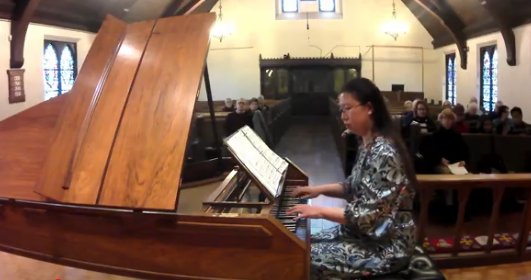
Now on YouTube – More About this Event – Printable Program
Anastasia Chin’s “A Springtime Salon” of music of the Classical era (with one excursion into early Romanticism) completely captured the audience at St. Michael and All Angels Church in Portland on Saturday, March 15, 2025. With extensive experience and study of both harpsichord and fortepiano, Anastasia Chin holds a Doctor of Music in Early Music from the Indiana University Jacobs School of Music. A top prize winner of the 2021 Jurow International Harpsichord Competition and 2018 Berkeley Festival International Early Piano Competition, her sensitive, exquisite playing on a perfectly balanced Viennese-action eighteenth-century fortepiano in the resonant acoustics of the chapel provided an intimate, completely satisfying experience.
The opening Sonata in E-flat Minor by Marianna Auenbrugger (1759-1782) immediately launched us into the world of Viennese Classicism, with its natural, singing treble lines and simple harmonic accompaniments, peppered with some dramatic excursions. Chin’s deeply felt expressivity was especially notable in the middle Largo movement, while the final Rondo Allegro’s sparkly opening gave way at times to contrasting stormy sections.
Chin brought an intimate quality to four of the Bagatelles Op. 33 by Ludwig van Beethoven (1770-1827), compositions which explore a variety of contrasting registers and sections. Chin played No. 1 in E-Flat Major; No. 4 in A major – having a lyrical, hypnotic primary section and contrasting registers; the more fiery No. 5 in C Major – whose musical joke at the end brought audible chuckles from the audience; and No. 6 in D Major – with lovely phrasing and balanced voicing throughout.
Next, Chin played the highly inventive Fantaisie in G Minor by French composer and pianist Hélène de Montgeroult (1764-1836). From the first chords, Chin weaved a spell that took us on a wild journey through dramatically contrasting sections. Chin masterfully explored the rhetorical freedom and drama integral to this composition, with full exploration of the 5-octave eighteenth-century fortepiano, and effective use of the damper-raising knee levers that blended full textures and arpeggiated figures. For the close, after dramatic swirls to the top, Chin played the final low tone in a contemplative manner.
The final composition was the Sonata in B-Flat Major, K. 570 by Wolfgang Amadeus Mozart (1756-1791). Chin’s lyricism and expressiveness shone in this well-known piece, including dramatic register contrasts. In the middle Adagio movement, with its hymn-like A section, Chin’s expressivity through rhythmic flexibility was especially notable in the contrasting sections. In the sprightly final Allegretto, Mozart – and Chin – exploited the full range and colors of the eighteenth-century piano.
Throughout, Anastasia Chin demonstrated her mastery of the Classical spirit, with its nuanced dynamics and rhythmic flexibility, and above all, expression of a wide variety of human emotions. In fact, Chin’s playing is remarkable for its integrity in expressing the full palette of colors and characters contained within Classicism. Chin’s light touch on the fortepiano enabled the instrument to sing with its natural tone, and the audience was enchanted. In addition to Chin’s expressivity, the fortepiano used for this program — a copy by Thomas and Barbara Wolf of the Smithsonian’s approximately 1789 Dulcken, recently restrung by Paul Irvin with Stephen Birkett’s historical wire – was simply outstanding. The long sustain enabled Chin’s melodies truly to sing, and the tone was balanced throughout, with contrasting register colors; bass, tenor, alto, and treble each had its own sound quality, yet all were equal in projection and clarity.
Also, learn more about Viennese-style versus English-style fortepianos in this video. – Watch the video
Review by Carol lei Breckenridge